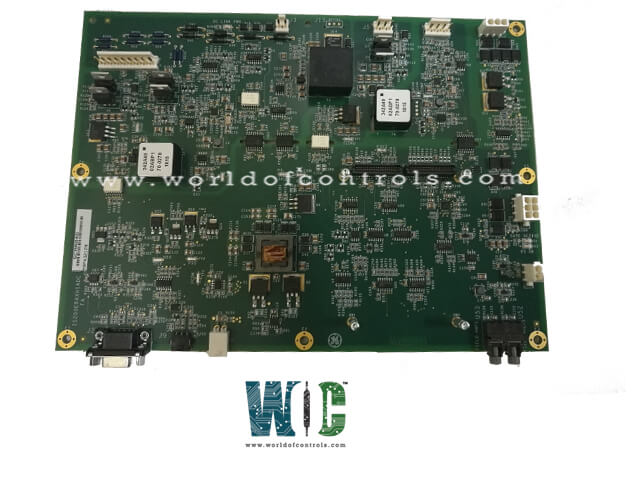SPECIFICATIONS
Part No.: IS200ERAXH1ACB
Manufacturer: General Electric
Country of Manufacture: United States of America (USA)
Size: 33.02 cm high x 10.16 cm wide
Product Type: Exciter Regulator Auxiliary I/O Module
Availability: In Stock
Series: EX2100
Functional Description
IS200ERAXH1ACB is an exciter regulator auxiliary I/O module developed by GE. It is a part of EX2100 excitation system. As an exciter regulator auxiliary I/O module, it plays a crucial role in regulating and managing various auxiliary functions associated with excitation systems. It interfaces and operate efficiently with Level 3 IGBT systems, handling power regulation and control within the excitation system.�
Product Attributes
- The EAUX board is equipped with two relay driver outputs that are essential for the operation of the EXAM module. The first relay driver output is used for selecting between the M1 or M2 redundant FGD, ensuring the system's flexibility and reliability.
- The second relay driver output controls a test relay, which is instrumental in temporarily inserting a ground resistance to test the FGD function. It's important to note that the test relay is only present on version EXAM_B and later versions.
- In applications involving the EX2100e Regulator, the EXAM board is directly connected to and controlled by the ERAX board. This configuration highlights the EXAM's role in providing essential feedback and control mechanisms within the larger excitation control system.
- The module's primary function involves facilitating communication, control, and monitoring of auxiliary signals, allowing seamless integration and management of auxiliary modules within the EX2100 system. Through its I/O capabilities, it enables the exchange of data, signals, and commands between the exciter regulator and various auxiliary components, contributing to the overall performance and reliability of the excitation system.
Functionality and Integration
- In regulator application, the ERAX board replaces the EAUX board, underscoring the adaptability of the system to different configurations. The module is strategically mounted within the High Voltage Interface (HVI) module, which is housed in the auxiliary cabinet.
- This positioning allows the EXAM to effectively provide attenuation between the field bus and the EAUX by sensing high voltage from the bridge and scaling it to a manageable level that the system can use.
Connectivity and Redundancy
- A key feature of the EXAM module is its connection to the EAUX via a single J2 9-pin cable. This straightforward connection ensures efficient communication between the boards. In redundant control systems, the field ground detector (FGD) is designed to be controllable from either M1 or M2. This redundancy ensures that the FGD remains operational even if one of the master controls is out of service. The EAUX board generates a +/- 50 V square wave signal which is sent to the EXAM.
- The EXAM, in turn, provides analog feedback proportional to the ground current back to the EAUX.
System Features
- The EX2100 Excitation Control system, often referred to as the exciter, serves a pivotal role in managing the field excitation current, thereby regulating the alternating current (AC) terminal voltage and reactive volt-amperes of generators across various power generation setups. This full static excitation system is purposefully designed to cater to generators linked to steam, gas, and hydro turbines, offering both new installations and retrofits a reliable and adaptable solution.
- Characterized by its modular design, the exciter system offers substantial flexibility by allowing configurations that cater to different output current requirements and varying levels of redundancy within the system. These configurations encompass the utilization of power from potential, compound, or auxiliary sources, offering options for single or multiple bridges, warm backup bridges, and simplex or redundant controls. This modular approach ensures adaptability to diverse operational needs and enhances system reliability.
- Power for the exciter is sourced from either a power potential transformer linked to the generator terminals or an excitation transformer connected to an auxiliary bus. Crucial feedback for the exciter's operation is derived from the generator line current and stator output voltage, serving as primary inputs. Meanwhile, the exciter's output control involves managing direct current (DC) voltage and current to regulate the exciter field effectively.
- In terms of its architecture, the system is equipped to support Ethernet LAN communication via the Unit Data Highway, allowing seamless connectivity and interaction with other GE equipment. This includes integration capabilities with the GE Control System Toolbox for configuration purposes, coordination with the turbine control, collaboration with the LCI Static Starter, and interaction with the Human-Machine Interface (HMI) for operator interfacing. This robust communication infrastructure enhances interoperability and facilitates efficient monitoring, control, and configuration of the excitation system alongside other associated GE equipment.
The WOC team is always available to help you with your EX2100 requirements. For more information, please contact WOC.
Frequently Asked Questions
What is IS200ERAXH1ACB?
It is an Exciter Regulator Auxiliary I/O Module developed by GE under the EX2100 series.
What makes the exciter system flexible?
Its modular design allows configurations catering to different output current requirements and varying levels of redundancy. It can use power from potential, compound, or auxiliary sources, offering options for single or multiple bridges and simplex or redundant controls.
How does the exciter regulate the excitation field?
It controls the excitation field by managing DC voltage and current. This regulation ensures stable AC terminal voltage and reactive volt-amperes in generators.
What are the primary inputs for the exciter's operation?
Crucial inputs include feedback from generator line current and stator output voltage. These inputs contribute to the effective control of the excitation field.
What communication capabilities does it have?
The system supports Ethernet LAN communication via the Unit Data Highway, enabling seamless connectivity with other GE equipment. This includes integration with the GE Control System Toolbox, turbine control, LCI Static Starter, and Human-Machine Interface (HMI) for efficient monitoring and control.
